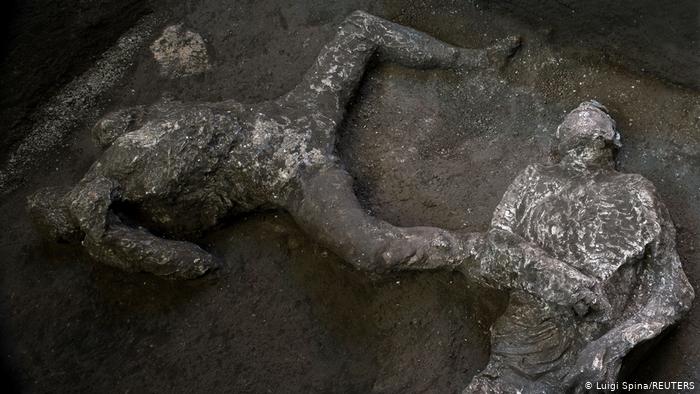Pompeii dig uncovers 2000-year-old remains of rich man and slave killed by Vesuvius volcanic eruption
Archaeologists uncovered the skeleton remains of two males who perished about 2,000 years ago in Pompeii, Italy, after the eruption of Mount Vesuvius in 79 AD. The bones are thought to be those of a wealthy man and his male slave who attempted to flee the volcano’s explosion.

During an excavation of the ruins from what was once an elegant villa with a panoramic view of the Mediterranean Sea on the outskirts of the ancient Roman city, parts of the skulls and bones of the two men were found.
The remains of the two victims, lying next to each other on their backs, were found in a layer of grey ash at least 2 meters (6.5 feet) deep. In 2017, a stable with the remains of three harnessed horses was also found in the same area.
In a statement issued by Pompeii officials, they said that the men apparently escaped the initial fall of ash from Mount Vesuvius but then succumbed to a powerful volcanic blast that took place the next morning. The later blast “apparently invaded the area from many points, surrounding and burying the victims in ash,” the officials said.
Judging by cranial bones and teeth, one of the men was young, likely aged 18 to 25, with a spinal column with compressed discs. That finding led archaeologists to hypothesize that he was a young man who did manual labour, like that of a slave.
The other man had a robust bone structure, especially in his chest area, and died with his hands on his chest and his legs bent and spread apart.
He was estimated to have been 30- to 40-years-old, Pompeii officials said. Fragments of white paint were found near the man’s face, probably remnants of a collapsed upper wall, the officials said.
Based on the impression of fabric folds left in the ash layer, it appeared the younger man was wearing a short, pleated tunic, possibly of wool. The older victim, in addition to wearing a tunic, appeared to have had a mantle over his left shoulder, said reports.
According to a report by The Associated Press, both skeletons were found in a side room along an underground corridor, or passageway, known in ancient Roman times as a cryptoporticus, which led to to the upper level of the villa.
Pompeii archaeological park director general, Massimo Osanna said that the find was “truly exceptional”, while Italian culture minister Dario Franceschini said it underlined the importance of Pompeii as a place for study and research.
Osanna further stated, “The victims were probably looking for shelter in the cryptoporticus, in this underground space, where they thought they were better protected. Instead, on the morning of Oct. 25, 79 A.D., a blazing cloud (of volcanic material) arrived in Pompeii and…killed anyone it encountered on its way.”
The famous Mount Vesuvius is located near Naples in Italy and is well known throughout the world for its massive destructive eruption. It is also known as Vesuvio among the locals and stands 4,203 feet (1,281 meters) tall and has a semi-circular ridge called Mount Soma that rises 3,714 feet.
It has erupted over 50 times and remains an active volcano till date.





